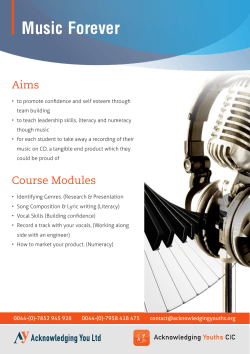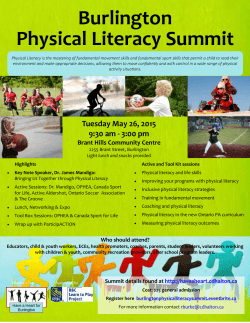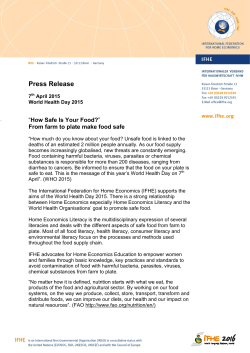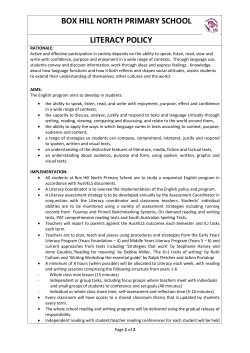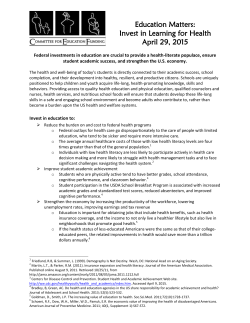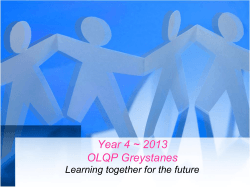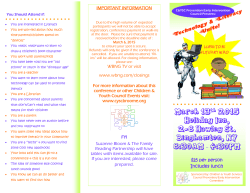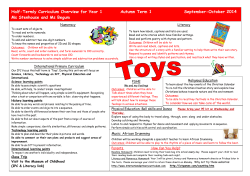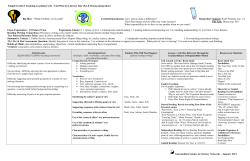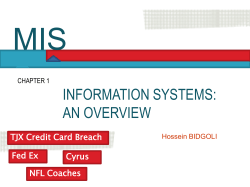
Learning At Home and “On the Go” Series
Sophia E. Pappas, Executive Director Learning At Home and “On the Go” Series A Parent Guide to Literacy in Early Childhood Pre-k programs use the New York State Prekindergarten Foundation for the Common Core to support literacy development in young children. Focus on Literacy – A love of reading begins long before your child starts pre-k. Every time you hold your child and read aloud, your child experiences the joys of reading and connects to the reading experience. You can help your child develop literacy and reading skills to help him/her become a successful independent reader in the future. Literacy as a source of enjoyment – You want your child to enjoy looking at books and having books read to him. When they are excited about what they are hearing, they are motivated to learn to read. What we know from research -Children are more likely to be fluent readers and enjoy reading more if parents have fun reading to them and if they show children that reading books is a source of enjoyment (Snow, Burns & Griffin, 1998). How to help your child – Show your child the importance of reading by talking about books every day. Make literacy a fun thing to do. Visit the local library regularly and register to get your child a library card. Let your child select books to take home. Let your child pretend to read the pictures and you can read the story to your child. Keep story time warm and enjoyable. Literacy is building vocabulary and language – Literacy begins with listening and speaking. Infants listen to familiar voices and they babble in response. Later, your child begins to organize their thoughts and ideas and begin to speak. They move from speaking skills to written language. As they learn more words, they begin to make connections to reading and writing and begin to make sense of printed words. What we know from research - Exposing children to new vocabulary words often and in various ways can have a significant effect on the development of increased reading vocabulary. (Senechal, 1997; Leung, 1992: Daniels, 1994, 1996: Dole, Sloan, & Trathen, 1995) How to help my child – Talk with your child. Add to what they say. For example, if your child says, “Go outside,” you can say, “Would you like to go outside today? We can go outside right after we finish cleaning up the kitchen.” Ask your child questions. Explain the meaning of words. Talk about things that happened yesterday and what might happen in the future. Read to your child daily and talk about the stories. Sing songs and play rhyming games with words. Read informational books about rocks, trees, animals, people or ideas to introduce new ideas and build vocabulary. Literacy is learning about the sounds in words. Your child begins to learn the sounds of letters and words. This includes hearing and understanding different sounds, patterns of spoken language and how words are put together. What we know from research – Phonemic awareness is central in learning to read and spell (Ehri, 1984). How to help my child - Sing songs, read stories and play rhyming games. Ask your child to make up a new verse to a song. Create a cleanup song, a bedtime rhyme, a chant for getting ready for school. You can also point out words that start with the same sounds as your child's name and clap syllables in your family member's names. Sophia E. Pappas, Executive Director Literacy is building knowledge of print – Your child learns that print has many purposes. They learn that we read signs to find out where to go or what to do. We use print to give messages to others; we write messages, we read menus, and we express ideas and feelings to others. Before children learn to read, they recognize meaningful words like their name and the names of restaurants and products in a store. These are the building blocks of later reading skills. What we know from research – Children as young as three years old know that print carries a message (McGee, Richgels, Charlworth, 1986). How to help my child – Help your child read logos of restaurants and stores you visit, as well as print on items you buy often like toothpaste, snacks and cereal. Read calendars, recipes, greeting cards, labels, children’s newspapers and magazines. Help children write words that are important to them. Literacy is building knowledge of letters and words- Your child learns to match a letter sound to a letter and recognize spoken words to written words. What we know from research – Children’s own names are highly motivating for learning letter names (Share & Jaffe-Gur, 1999; Bloodgood, 1999). How to help my child – Read alphabet books so your child sees the connection of letters to things that have meaning for them. Talk about the letters in your child’s name and other people your child knows. Sing the alphabet song. Talk about the shapes of letters like some have circles, dots or straight lines. Write words that are important to your child on cards with pictures like names of people or pets they know. Literacy is building comprehension – Your child begins to make meaning out of reading. They connect what they read with their experience. Good readers have background knowledge that helps them understand language. What we know from research – Comprehension is essential to future reading success because it enables children to process what they hear and read (Teale & Yokota, 2000). How to help my child – Introduce your child to new words as you visit places and see things. Encourage your child to ask questions and you can also ask clarifying questions. For example, you can ask, “What do you mean?” Ask your child to tell you what is happening in a picture or to retell familiar stories. Literacy is building books and other text – Expose your child to various types of books. Some genres of books include: informational, nonfiction, concept books, wordless books, fiction, fantasy, fairy tales, folklore, historical fiction, poetry, storybooks, picture books, biographies, autobiographies, books about people and animals, and songbooks. What we know from research Greater attention to informational texts will make children better readers and writers of informational text (Christie, 1984, 1987). How to help my child – Expose your child to a variety of types of books like those above. Talk about how books are similar and different. Use books for information and to learn new things. (Literacy, The Creative Curriculum, Cate Heroman, Candy Jones, 2004) (Snow, 1998) (Senechal & Leung) (Ehri, 1995) (McGee, 1986) (Share & Jaffe-Gur & Bloodgood, 2010) (Yokota, 2000) (Christie, 1991) For more information: http://families.naeyc.org/ http://www.pbs.org/parents http://www.sesamestreet.org/parents Brought to you by The Office of Early Childhood Education www.nyc.gov/schools/earlychildhood Tel: 212-374-0351 Email: earlychildhood@schools.nyc.gov You can find information about Pre-K programs on our website. http://schools.nyc.gov/ChoicesEnrollment/PreK
© Copyright 2025

